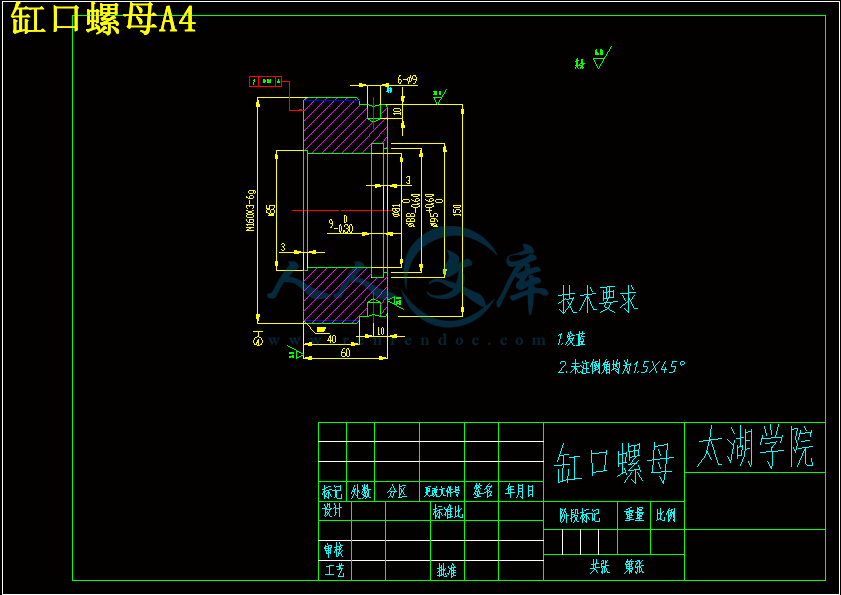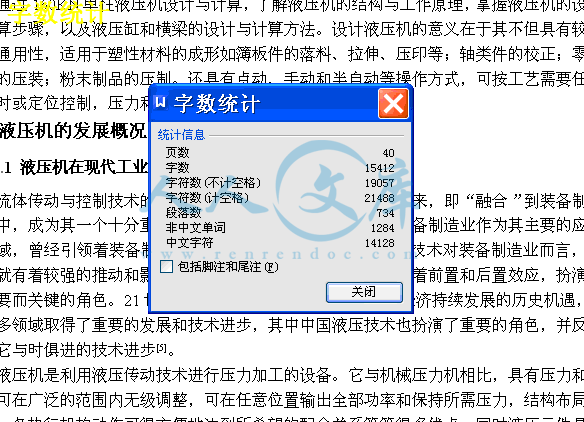摘 要
作为现代机械设备实现传动与控制的重要技术手段,液压技术在国民经济各领域得到了广泛运用。作为世界加工中心,我国机械工业在国民经济中的基础作用越来越明显。液压机技术水平的高低直接影响到国家机械工业的发展水平。单柱式液压机是液压机产品的一个重要组成部分, 8000KN以下的小型锻造液压机常采用C型单臂机架,主要用于轴类零件、型材的校正和轴套类零件的装配,也可用于板材的弯曲成型、拉伸等工艺过程。配置一定的附件式模具后可进行粉末压制成型和固型塑料的成型压制,拥有自主的液压机设计技术是使国家机械工业能在世界竞争中取胜的重要保证,对其展开研究有重要的理论和实际意义。本文完成了160KN单柱式液压机本体的设计,并采用二维制图软件AutoCAD对其进行研究。论文提出了160KN单柱式液压机的技术参数,拟定了机器的结构形式,着重对工作缸做了结构设计和数据计算。根据液压机设计理论完成了整体机架结构及主要结构部件的设计与理论计算。对液压机本体的总体结构和关键部件进行了强度计算与分析,主要内容包括:结构中应力集中情况分析,初始设计方案修正,最终获得了满足强度和刚度要求的机架设计。最后利用AutoCAD软件对160KN单柱式液压机总装配图及主要零部件进行了设计,完成了液压机的整体结构设。
关键词:液压机;工作缸;强度
Abstract
As one of the important technical means to achieve the modern machinery equipment transmission and control, hydraulic technology has been widely used in the field of the national economy. As a processing center in the world, China's machinery industry foundation function in the national economy is more and more obvious. Hydraulic machine technology level directly affects the development level of the national machinery industry. Single column hydraulic machine is an important part of the hydraulic machine, small forging under 8000KN hydraulic press often uses the “C” type single arm frame, mainly used for shaft parts profile correction and sleeve parts assembly, can also be used for such as tensile plate bending forming process configuration must be the attachment type of mold powder can be suppressed after molding and plastic molding repression, hydraulic machine design technology with independent is an important guarantee to make the national machinery industry can win in the international competition, the expansion has important theoretical and practical significance to study. The design of the 160KN bulk single column hydraulic machine, and the use of 2D drawing software AutoCAD to study the. This paper presents the technical parameters of 160KN single column hydraulic machine, the structure of machine, the working cylinder structure design and calculation of the data. Design and theoretical calculation of the whole frame structure and the main part of the structure was completed according to the design theory of hydraulic machine. The key components of overall structure of the hydraulic machine body and gives the calculation and analysis of the strength, the main contents include: the stress concentration analysis of structure, modify the initial design scheme, finally satisfied frame design strength and stiffness requirements. At the end of the 160KN single column hydraulic machine assembly drawing and the main parts were designed by using AutoCAD software, completed the overall structure design of hydraulic machine.
Keywords: hydraulic machine;hydraulic cylinder;strength
目 录
摘 要 III
Abstract IV
目 录 V
1 绪论 1
1.1 课题背景及目的与意义 1
1.2 液压机的发展概况 1
1.2.1 液压机在现代工业中的地位 1
1.2.2我国液压机的现状及发展趋势 1
1.2.3 国外液压机的发展状况 3
1.2.4 液压机的总体发展趋势 4
1.3 液压机的工作原理和结构特点 4
1.3.1 液压机的工作原理 4
1.3.2 液压传动的优缺点 5
1.4 液压机的分类 6
2 液压机本体结构设计 8
2.1 液压机的结构特点及设计参数 8
2.1.1 液压机本体结构特点 8
2.1.2 160KN液压机的设计参数 8
2.2 上横梁结构的设计 9
2.3工作台结构的设计 9
2.3.1 结构形式 9
2.3.2 加工技术要求 10
2.3.3 固定模具的结构 10
3 液压机液压系统原理图设计 12
3.1 明确设计要求,制定基本方案 12
3.1.1 设计要求 12
3.1.2 确定液压执行元件的形式 12
3.1.3 确定液压执行元件运动控制回路 13
3.1.4 液压源系统 13
3.2 液压系统各液压元件的确定 13
3.2.1 液压介质的选择 13
3.2.2 拟定液压系统图 14
3.3 液压系统主要参数计算 16
3.3.1 选系统工作压力 16
3.3.2 液压缸设计中应注意的的问题 16
3.3.3 液压缸主要参数的确定 16
3.3.3 液压缸强度校核 17
3.3.4 液压缸稳定性校核 18
3.4 液压阀的选择 21
3.4.1 液压阀的作用 21
3.4.2 液压阀的基本要求 21
3.4.3 液压阀的选择 21
3.5 液压泵的选择 22
3.6 电动机功率的确定 22
3.7 液压管件的确定 23
3.7.1 油管内径确定 23
3.7.2 管接头 23
3.8 本章小结 23
4 液压机的强度与刚度计算 25
4.1 上横梁结构的强度与刚度计算 25
4.1.1 受力分析 25
4.1.2 主截面(Ⅰ—Ⅰ)强度计算 26
4.1.3 主截面(Ⅱ—Ⅱ)强度计算 26
4.2 本章小结 27
结 论 28
致 谢 29
参考文献 30
1 绪论
1.1 课题背景及目的与意义
通过160KN单柱液压机设计与计算,了解液压机的结构与工作原理,掌握液压机的设计计算步骤,以及液压缸和横梁的设计与计算方法。设计液压机的意义在于其不但具有较大的通用性,适用于塑性材料的成形如簿板件的落料、拉伸、压印等;轴类件的校正;零部件的压装;粉末制品的压制。还具有点动、手动和半自动等操作方式,可按工艺需要任选定时或定位控制,压力和行程可调,操作灵便、工作可靠。
1.2 液压机的发展概况
1.2.1 液压机在现代工业中的地位
流体传动与控制技术的主要代表液压技术自上世纪初面世以来,即“融合”到装备制造业中,成为其一个十分重要的基础领域,同时,液压技术将装备制造业作为其主要的应用领域,曾经引领着装备制造业一系列的技术进步[8]。因此液压技术对装备制造业而言,从来就有着较强的推动和影响作用,对装备制造业等诸多领域有着前置和后置效应,扮演着重要而关键的角色。21世纪初,中国装备制造业得益于国民经济持续发展的历史机遇,在诸多领域取得了重要的发展和技术进步,其中中国液压技术也扮演了重要的角色,并反映了它与时俱进的技术进步[5]。
液压机是利用液压传动技术进行压力加工的设备。它与机械压力机相比,具有压力和速度可在广泛的范围内无级调整,可在任意位置输出全部功率和保持所需压力,结构布局灵活,各执行机构动作可很方便地达到所希望的配合关系等等很多优点。同时液压元件具有高度的通用化、标准化特点,设计及制造均较为简单,所以液压机在国民经济各部门得到了日益广泛的应用[15]。
1.2.2我国液压机的现状及发展趋势
我国液压机的现状:我国液压技术的发展始于20世纪50年代,最初主要应用于机床和锻压设备上;20世纪60年代,我国从国外引进了一些液压元件生产技术,同时自行设计开发出了液压产品;20世纪80年代初期,我国又从美国、日本、德国引进了一些先进的技术和设备,是我国的液压技术水平有了很大的提高。目前,我国的液压元件已从低压到高压形成了系列产品,并开发生产出了许多新型的液压元件;在精度、重载大型设备的液压系统中,国产元件的应用也越来越多;行走机械液压系统中的专用液压元件也在大力开发。液压技术在我国经济建设和社会发展中将发挥越来越大的基础性和关键性的支撑作用[16]。下图1.1是滕州机械厂生产的单臂液压铸造机。










 川公网安备: 51019002004831号
川公网安备: 51019002004831号